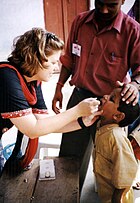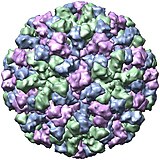Portal:Viruses
The Viruses Portal
Welcome!

Viruses are small infectious agents that can replicate only inside the living cells of an organism. Viruses infect all forms of life, including animals, plants, fungi, bacteria and archaea. They are found in almost every ecosystem on Earth and are the most abundant type of biological entity, with millions of different types, although only about 6,000 viruses have been described in detail. Some viruses cause disease in humans, and others are responsible for economically important diseases of livestock and crops.
Virus particles (known as virions) consist of genetic material, which can be either DNA or RNA, wrapped in a protein coat called the capsid; some viruses also have an outer lipid envelope. The capsid can take simple helical or icosahedral forms, or more complex structures. The average virus is about 1/100 the size of the average bacterium, and most are too small to be seen directly with an optical microscope.
The origins of viruses are unclear: some may have evolved from plasmids, others from bacteria. Viruses are sometimes considered to be a life form, because they carry genetic material, reproduce and evolve through natural selection. However they lack key characteristics (such as cell structure) that are generally considered necessary to count as life. Because they possess some but not all such qualities, viruses have been described as "organisms at the edge of life".
Selected disease
Chickenpox is caused by initial infection with varicella zoster virus, a DNA virus of the Alphaherpesvirinae subfamily. The virus naturally infects only humans, but some other primates have been infected artificially. Symptoms appear 10–21 days after exposure: an itchy vesicular skin rash, and small ulcers in the oral cavity and tonsil areas. The rash usually resolves by 7 days, but the virus remains latent in nerve cell bodies, and can emerge years or decades later to cause shingles. Chickenpox is transmitted by the respiratory route, as well as direct contact with lesions.
A classic disease of childhood, the highest prevalence occurs at 4–10 years. Chickenpox is rarely fatal in people with a normal immune system, with around 6,400 deaths worldwide in 2015, about 1 in 60,000 infections. Adults often have more severe symptoms than children, and are at higher risk of complications such as pneumonia, bronchitis, hepatitis and encephalitis. Pregnant women and people with a suppressed immune system have the highest complication risk. Chickenpox during the first 28 weeks of gestation can lead to foetal malformations. Infection in adults is usually treated with antiviral drugs, such as aciclovir or valaciclovir, which reduces symptom severity and the risk of complications. A vaccine is available.
Selected image
Haemagglutinin, a glycoprotein trimer on the influenza virus envelope, binds to the sialic acid-containing receptor on the host cell. After the virus has been engulfed into an endosome, it changes configuration, causing the viral and endosomal membranes to fuse, releasing the viral genome into the cytoplasm.
Credit: Jawahar Swaminathan (EBI) (16 November 2008)
In the news
26 February: In the ongoing pandemic of severe acute respiratory syndrome coronavirus 2 (SARS-CoV-2), more than 110 million confirmed cases, including 2.5 million deaths, have been documented globally since the outbreak began in December 2019. WHO
18 February: Seven asymptomatic cases of avian influenza A subtype H5N8, the first documented H5N8 cases in humans, are reported in Astrakhan Oblast, Russia, after more than 100,0000 hens died on a poultry farm in December. WHO
14 February: Seven cases of Ebola virus disease are reported in Gouécké, south-east Guinea. WHO
7 February: A case of Ebola virus disease is detected in North Kivu Province of the Democratic Republic of the Congo. WHO
4 February: An outbreak of Rift Valley fever is ongoing in Kenya, with 32 human cases, including 11 deaths, since the outbreak started in November. WHO
21 November: The US Food and Drug Administration (FDA) gives emergency-use authorisation to casirivimab/imdevimab, a combination monoclonal antibody (mAb) therapy for non-hospitalised people twelve years and over with mild-to-moderate COVID-19, after granting emergency-use authorisation to the single mAb bamlanivimab earlier in the month. FDA 1, 2
18 November: The outbreak of Ebola virus disease in Équateur Province, Democratic Republic of the Congo, which started in June, has been declared over; a total of 130 cases were recorded, with 55 deaths. UN
Selected article
Vaccination or immunisation is the administration of immunogenic material (a vaccine) to stimulate an individual's immune system to develop adaptive immunity to a virus or other pathogen, and so develop protection against an infectious disease. The active agent of a vaccine may be intact but inactivated or weakened forms of the pathogen, or purified highly immunogenic components, such as viral envelope proteins. Smallpox was the first disease for which a vaccine was produced, by Edward Jenner in 1796.
Vaccination is the most effective method of preventing infectious diseases and can also ameliorate the symptoms of infection. When a sufficiently high proportion of a population has been vaccinated, herd immunity results. Widespread immunity due to mass vaccination is largely responsible for the worldwide eradication of smallpox and the elimination of diseases such as polio from much of the world. Since their inception, vaccination efforts have met with objections on scientific, ethical, political, medical safety and religious grounds, and the World Health Organization considers vaccine hesitancy an important threat to global health.
Selected outbreak
The last recorded smallpox death occurred during the 1978 smallpox outbreak in Birmingham, UK. The outbreak resulted from accidental exposure to the Abid strain of Variola major, from a laboratory, headed by Henry Bedson, at the University of Birmingham Medical School – also associated with an outbreak in 1966. Bedson was investigating strains of smallpox known as whitepox, considered a potential threat to the smallpox eradication campaign, then in its final stages.
A medical photographer who worked on the floor above the laboratory showed smallpox symptoms in August and died the following month; one of her contacts was also infected but survived. The government inquiry into the outbreak concluded that she had been infected in late July, possibly via ducting, although the precise route of transmission was subsequently challenged. The inquiry criticised the university's safety procedures. Bedson committed suicide while under quarantine. Radical changes in UK research practices for handling dangerous pathogens followed, and all known stocks of smallpox virus were concentrated in two laboratories.
Selected quotation
| “ | There is no question that virology has long outgrown the confines of "Microbiology": it is an important discipline in its own right, a fact that is attested by the numerous high quality journals that are exclusively devoted to it. Further, it is primarily virology that has made possible the rapid rise of molecular cell biology. | ” |
—Bill Joklik on founding a society for virology
Recommended articles
Viruses & Subviral agents: bat virome • elephant endotheliotropic herpesvirus • HIV • introduction to viruses![]() • Playa de Oro virus • poliovirus • prion • rotavirus
• Playa de Oro virus • poliovirus • prion • rotavirus![]() • virus
• virus![]()
Diseases: colony collapse disorder • common cold • croup • dengue fever![]() • gastroenteritis • Guillain–Barré syndrome • hepatitis B • hepatitis C • hepatitis E • herpes simplex • HIV/AIDS • influenza
• gastroenteritis • Guillain–Barré syndrome • hepatitis B • hepatitis C • hepatitis E • herpes simplex • HIV/AIDS • influenza![]() • meningitis
• meningitis![]() • myxomatosis • polio
• myxomatosis • polio![]() • pneumonia • shingles • smallpox
• pneumonia • shingles • smallpox
Epidemiology & Interventions: 2007 Bernard Matthews H5N1 outbreak • Coalition for Epidemic Preparedness Innovations • Disease X • 2009 flu pandemic • HIV/AIDS in Malawi • polio vaccine • Spanish flu • West African Ebola virus epidemic
Virus–Host interactions: antibody • host • immune system![]() • parasitism • RNA interference
• parasitism • RNA interference![]()
Methodology: metagenomics
Social & Media: And the Band Played On • Contagion • "Flu Season" • Frank's Cock![]() • Race Against Time: Searching for Hope in AIDS-Ravaged Africa
• Race Against Time: Searching for Hope in AIDS-Ravaged Africa![]() • social history of viruses
• social history of viruses![]() • "Steve Burdick" • "The Time Is Now" • "What Lies Below"
• "Steve Burdick" • "The Time Is Now" • "What Lies Below"
People: Brownie Mary • Macfarlane Burnet![]() • Bobbi Campbell • Aniru Conteh • people with hepatitis C
• Bobbi Campbell • Aniru Conteh • people with hepatitis C![]() • HIV-positive people
• HIV-positive people![]() • Bette Korber • Henrietta Lacks • Linda Laubenstein • Barbara McClintock
• Bette Korber • Henrietta Lacks • Linda Laubenstein • Barbara McClintock![]() • poliomyelitis survivors
• poliomyelitis survivors![]() • Joseph Sonnabend • Eli Todd • Ryan White
• Joseph Sonnabend • Eli Todd • Ryan White![]()
Selected virus
Noroviruses are a genus of non-enveloped, single-stranded RNA viruses in the family Caliciviridae. The positive-sense RNA genome is approximately 7500 nucleotides long. Known noroviruses fall into five different genogroups (GI–GV); three groups infect humans, the other two mice, and cattle and other bovines. All are considered strains of a single species, Norwalk virus.
Noroviruses are extremely contagious, with fewer than 20 virus particles being infectious. They are transmitted directly from person to person and indirectly via contaminated water and food. After infection, the virus replicates in the small intestine, causing acute gastroenteritis, which develops 12–48 hours after exposure and lasts for 24–72 hours. The characteristic symptoms include nausea, forceful vomiting, watery diarrhoea and abdominal pain. Infection is usually self-limiting and rarely severe. Noroviruses cause 18% of acute gastroenteritis episodes in humans, with around 685 million cases and 200,000 deaths every year, mainly in very young, elderly or immunosuppressed people. No vaccine is available. Hand washing with soap and water is effective in reducing transmission.
Did you know?
- ...that virologist Harald zur Hausen received both the Gairdner Foundation International Award and the Nobel Prize in Physiology or Medicine in 2008?
- ...that in 2007, the first Australian outbreak of equine influenza caused a nationwide ban on horse racing?
- ...that Michael S. Gottlieb was instrumental in identifying AIDS in 1981 and thereafter treated actor Rock Hudson for the disease?
- ...that the tick Ornithodoros erraticus spreads the African swine fever virus in the Iberian Peninsula (Spain and Portugal)?
- ...that the CEO of CEPI, a key organisation in the race to develop a vaccine for COVID-19, has called the disease "the most frightening" that he has ever encountered in his career?
Selected biography
Jonas Edward Salk (28 October 1914 – 23 June 1995) was an American medical researcher and virologist, best known for developing the first successful polio vaccine.
Unlike most other researchers, Salk focused on creating an inactivated or "killed" virus vaccine, for safety reasons. The vaccine he developed combines three strains of wild-type poliovirus, inactivated with formalin. The field trial that tested its safety and efficacy in 1954 was one of the largest carried out to date, with vaccine being administered to over 440,000 children. When the trial's success was announced, Salk was hailed as a miracle worker and national hero. A little over two years later, 100 million doses of the vaccine had been distributed throughout the US, with few reported adverse effects. An inactivated vaccine based on the Salk vaccine is the mainstay of polio control in many developed countries.
Salk also researched vaccines against influenza and HIV. In 1960, he founded the Salk Institute for Biological Studies research centre in La Jolla, California.
In this month
May 1955: First issue of Virology; first English-language journal dedicated to virology
4 May 1984: HTLV-III, later HIV, identified as the cause of AIDS by Robert Gallo and coworkers
5 May 1939: First electron micrographs of tobacco mosaic virus taken by Helmut Ruska and coworkers
5 May 1983: Structure of influenza neuraminidase solved by Jose Varghese, Graeme Laver and Peter Colman
8 May 1980: WHO announced formally the global eradication of smallpox
11 May 1978: SV40 sequenced by Walter Fiers and coworkers
12 May 1972: Gene for bacteriophage MS2 coat protein is sequenced by Walter Fiers and coworkers, the first gene to be completely sequenced
13 May 2011: Boceprevir approved for the treatment of chronic hepatitis C virus (HCV) infection, the first direct-acting antiviral for HCV
14 May 1796: Edward Jenner inoculated James Phipps (pictured) with cowpox
15/16 May 1969: Death of Robert Rayford, the earliest confirmed case of AIDS outside Africa
18 May 1998: First World AIDS Vaccine Day
20 May 1983: Isolation of the retrovirus LAV, later HIV, by Luc Montagnier, Françoise Barré-Sinoussi and coworkers
23 May 2011: Telaprevir approved for the treatment of chronic HCV infection
25 May 2011: WHO declared rinderpest eradicated
31 May 1937: First results in humans from the 17D vaccine for yellow fever published by Max Theiler and Hugh H. Smith
Selected intervention
Several human papillomavirus (HPV) vaccines, including Cervarix and Gardasil, have been approved to protect against infections with particular types of HPV, associated with cervical and other cancers. All vaccines protect against the high-risk HPV types 16 and 18. Gardasil is a quadrivalent vaccine that additionally protects against low-risk HPV-6 and -11, which are associated with most cases of genital warts. A second-generation nine-valent Gardasil vaccine protects against five additional high-risk HPV types. It is estimated that the vaccines may prevent 70% of cervical cancer, 80% of anal cancer, 60% of vaginal cancer, 40% of vulvar cancer and possibly some oropharyngeal cancers. Protection lasts for at least 8–9 years. Some advocate giving Gardasil to men and boys with the primary aim of protecting their female sexual partners; others consider vaccinating only women and girls to be more cost effective. The licensed vaccines are subunit vaccines, containing only the L1 capsid protein of the virus, which self-assembles into virus-like particles. They are not effective in people already infected with HPV. Research is ongoing into therapeutic HPV vaccines including the viral oncoproteins, E6 and E7, but none has yet been licensed.
Subcategories
Subcategories of virology:
Topics
Things to do
- Comment on what you like and dislike about this portal
- Join the Viruses WikiProject
- Tag articles on viruses and virology with the project banner by adding {{WikiProject Viruses}} to the talk page
- Assess unassessed articles against the project standards
- Create requested pages: red-linked viruses | red-linked virus genera
- Expand a virus stub into a full article, adding images, citations, references and taxoboxes, following the project guidelines
- Create a new article (or expand an old one 5-fold) and nominate it for the main page Did You Know? section
- Improve a B-class article and nominate it for Good Article
 or Featured Article
or Featured Article status
status - Suggest articles, pictures, interesting facts, events and news to be featured here on the portal
WikiProjects & Portals
 WikiProject Viruses
Related WikiProjects
WikiProject Viruses
Related WikiProjects
Medicine • Microbiology • Molecular & Cellular Biology • Veterinary Medicine
Related PortalsAssociated Wikimedia
The following Wikimedia Foundation sister projects provide more on this subject:
-
Commons
Free media repository -
Wikibooks
Free textbooks and manuals -
Wikidata
Free knowledge base -
Wikinews
Free-content news -
Wikiquote
Collection of quotations -
Wikisource
Free-content library -
Wikispecies
Directory of species -
Wikiversity
Free learning tools -
Wiktionary
Dictionary and thesaurus



















